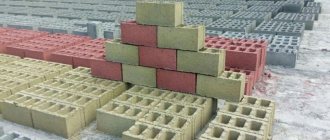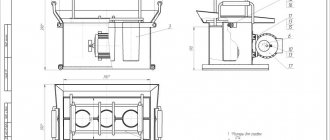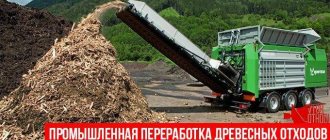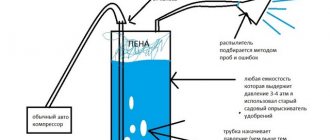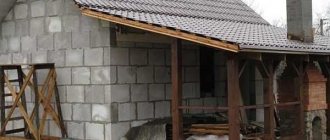Mechanical concrete mixer
There is also a disadvantage here, which is typical for all such concrete mixers using a cylindrical container for cement - mixing cement in the corners is sloppy and of poor quality. When the speed exceeds 35 per minute, the mixture scatters.
An old barrel is suitable for production; despite its unprepossessing appearance, it will be in no way inferior to modern industrially produced concrete mixers. In this case, the kneading speed is influenced more by revolutions rather than time. It is enough to scroll the mixture several times until it is completely ready.
One of the disadvantages is the very complex design of the concrete mixer itself. To make even the simplest manual version, you will need to stock up on a dozen different elements and spare parts.
When making a concrete mixer, all attention should be focused on the unloading hatch; look at how tightly the latches, seals and hinges fit. Each element must be strong and reliable, of high quality
Well, if there is no power nearby for an electric stirrer, then such a unit will be simply irreplaceable.
Preparation of drawings
The selected container must be displayed to scale on paper. All calculations and dimensions must be transferred to the plan diagram. The location of the frame stand, the barrel itself and additional fittings (mounts, rotating mechanisms, motor with a protective shield) are also displayed there.
If you lack artistic skills, you can always use ready-made plans for various models of concrete mixers.
Note!
- DIY vices: simple and reliable homemade vices from A to Z (190 photos)
Do-it-yourself vibrating table - selection of materials, components and assemblies for a vibrating table with a step-by-step manufacturing description
- Do-it-yourself grain crusher - operating principle, types and features of creating a device for processing grain crops
Existing types of concrete mixers
The main types of devices for preparing cement mortar or concrete are determined by the mixing method.
He can be:
- gravitational, based on the simple turning over of the constituent components of the mixture;
- mechanical, which resembles gravity, but to improve mixing, additional dissecting elements are added to the design;
- vibration, in which the mixture is prepared thanks to a vibrator immersed in it;
- combined, where two or three mixing methods are used simultaneously.
Each type of concrete mixer has its own positive and negative qualities, which depend on the cost of materials, the complexity of manufacturing and the required level of quality of the concrete solution prepared in them.
Self-production of a manual concrete mixer
A forced-action type concrete mixer is a classic of the presented device, which can be slightly modified depending on the need for use. Instructions are provided for production.
Device Basics
First you need to disassemble the main components of the concrete mixer. The following mandatory details are highlighted here:
- Container - a manual concrete mixer with your own hands can be used to make any containers: cans, barrels and specially pre-prepared bases. The means at hand will replace the usual-looking bucket.
- Frame or frame - a support for holding the container itself and a mechanism that drives it. A handle is screwed or welded to the support if you make a mechanical concrete mixer yourself, or a special electric drive that starts the container for a long time of mixing the mixture.
Main structural element
The drive itself - an electric concrete mixer - includes a special mechanism in its design, which is mainly used for large-scale work. If the concrete mixer is made for “home use”, in order to mix a small amount of mixture, you can use a manual drive - a handle or a wheel, which depends on the design of the future concrete mixer.
Components
The simplest forced-type mixer, with a horizontal drum arrangement and an electric drive, contains the following components:
- handle for unloading the finished mixture;
- rotating shaft with blades;
- mixing container;
- frame on which the container is mounted;
- electric motor;
- on/off remote control;
- gearbox
A forced-action mortar mixer with a vertical drum contains the same elements, only the frame is replaced with legs, the body is shaped like a bowl with an opening hatch for unloading, and the engine can be located on the side, bottom or top.
Disadvantages of use
- For electrical appliances, this is the opening of the hatch some time after the power supply has stopped and, as a result, the discharge of concrete (otherwise it will harden).
- In addition, concrete mixers are, in principle, seasonal. For the most part, they (especially small units) cannot be used at sub-zero temperatures. As a result, in winter it is necessary to additionally use a steam generator.
- Separately, it is worth highlighting the disadvantages of motor-driven devices - the high cost of the fuel used, the high noise level during operation, as well as the toxicity of the exhaust.
- A simple mortar mixer, capable of operating at a temperature not lower than +2 degrees, does not have equipment that ensures heating of the mixture.
- The productivity of manual units is quite low, while the labor intensity of mixing, on the contrary, is high.
Making a concrete mixer
Mixing of components occurs under the influence of the torque of the drum and gravity (gravity method). There is no question of any mixer like a blender or drill. The initial mixture is difficult to mix.
Operating principle
For cooking, during mixing, its entire volume must be used at once. Therefore, it is more profitable, both in terms of energy consumption and in terms of productivity, to mix the mixture in a drum under the influence of gravity. In addition, such an installation is easier to make at home.
Manufacturing of the installation, diagram
Source materials and equipment
To make such a device you will need at least some skills in working with metal structures and the ability to connect them.
The easiest way is to make the structure welded. Therefore, in addition to a set of necessary materials, you will also need a welding machine and, naturally, a person who knows how to handle it.
The following are suitable initial reliable materials that allow you to use the mixer almost indefinitely:
- A metal container in the shape of a cylinder is of sufficient thickness. This can be a barrel of 80-200 liters. However, the larger its volume and, accordingly, the mass of the loaded initial mixture, the harder it will be to rotate.
- Metal rod (reinforcement with a diameter of 8-12 mm), an angle with an edge of 25 mm for the stand and handles.
- Couplings, hinges, bearings.
Drawing
Manufacturing stages
Devices, the drawings of which are widely available in the public domain, may have individual parts, but are generally similar in design. Therefore, the process of their manufacture is divided into identical stages.
Let's consider one of the simplest options:
- Prepare a container. It could be an old iron barrel. The main thing is that it is strong enough and airtight, without cracks or holes.
- Make a small hatch in the middle of the side surface of the barrel. To do this, you need to carefully cut out a rectangle or square with a side of about 30 cm. From this piece you need to make a door for the hatch, securing it to the hinges of the barrel.
During operation, the hatch must reliably and, most importantly, hermetically close the barrel. For this it is better to use rubber seals. A strip of rubber can be glued around the perimeter of the hatch. The hatch itself must be closed before work using a latch or a regular door latch.
- Next, the drum (barrel with a hatch) needs to be secured to a rotating axis, which in turn is mounted on a reliable frame (See how shown in the photo). The connection of the axle attached to the barrel with the frame of the rack can be either using clamps that fit tightly into it, or through couplings with bearings.
DIY manual unit
- The stand on which the drum is mounted with a fixed handle and axis for rotation is made of durable material - metal corners, pipes, fittings, bars or boards of sufficient thickness.
Homemade electric installation
Electric drive
If a large amount of work is planned, for example, pouring the foundation for a two-story cottage, then a natural question arises for the builder - how to make an installation with an electric drive himself?
The addition of this part will have virtually no effect on the design of the device. Only in the place where the handle for manual rotation of the drum is located is an electric motor installed, directly connected to the drum axis or through a gearbox.
DIY electric installation
The electric motor must have sufficient power, although this all depends on the volume of the drum. So for a 200 liter barrel that produces 7-8 buckets of finished material in one cycle, it is necessary to install an engine with a power of at least 2 kW. In this case, the operating speed of the drum rotation should be in the range of 20-40 rpm.
Electric motor
Mobile installation
The cost of a homemade forced-action concrete mixer
Note: prices in the region of residence sdi1759 for 2017.
- Cut the metal into strips measuring 1000x1500 mm. One sheet is enough to make a clip for the tank. The second sheet will go to the bottom of the concrete mixer. Metal cost:
- Sheet 6 mm thick – 3600 rubles;
- Sheet 8 mm thick – 5800 rub.;
- Metal rolling and tack welding - RUB 3,400;
- Cut a circle with a diameter of 950 mm from a sheet of metal - 740 rubles;
- You also need to cut a window in the bottom for unloading the mixture.
sdi1759 calculated that if you make a tank with a wall and bottom thickness of 8 mm, weighing about 150 kg, it will cost him 15,800 rubles. If you squeeze it down - make the walls of the concrete mixer tank from steel 6 mm thick, and put 8 mm on the bottom + reinforcement with pipes, then the price of a tank weighing 120 kg is about 14,600 rubles. Delivery at your own expense.
You will also need:
- Worm gear – 5000 rub.
- Gasoline engine 6.5 hp. (was in stock).
- Turning work – 5-7 thousand rubles.
- Additional expenses – 5000 rub.
Total : about 33,000 rubles.
sdi1759
I sit and think. Should I make a tank from metal 8 mm or 6 mm thick? The difference in money is small. Is it worth saving on metal? I saw an industrial concrete mixer made from a “six”. It has been working in production for more than two years and has not broken down.
Main types of concrete mixers
There are several classifications of the unit described in the article, according to which it is divided according to one or another parameter. Thus, according to the principle of their operation, concrete mixers come in five varieties.
- Gravitational. They differ in that the drum for mixing the solution rotates under the influence of gravity. The best option for preparing viscous and rigid concrete.
- Forced. A more difficult to make concrete mixer with your own hands, where the container does not move, and the blades inside it mix the components of the mixture. Such units are rarely used in private construction.
- Periodic. They are characterized by low power and therefore require frequent stops. But for private construction this is a completely acceptable option.
- Geared (better known as crown-type).
- Permanent. Such concrete mixers, as their name suggests, operate continuously, and therefore are used primarily for large volumes of work.
In addition, depending on the type of concrete being produced, equipment can be of two types
- mortar mixers;
- concrete mixers.
Let's look at each of these options in more detail.
Option #1. Mortar mixers
Simple equipment designed for private construction. Designed for mixing components whose fraction size is more than 2 centimeters. Also, units can be industrial (if the volume does not exceed 1200 liters) and for private use (over 30 liters).
As a rule, all ingredients are mixed in mortar mixers forcibly, for which a horizontal auger is used, which rotates in a fixed container. If the volume of the unit is more than 100 liters, then it must be equipped with dispensers. And if the volume of equipment exceeds 250 liters, then, as a rule, it will include the following elements:
- engine;
- mixing container;
- drive unit;
- a rotating shaft having blades.
Option #2. Concrete mixers
They are designed for use with components whose fraction size is no more than 7 centimeters. All units of this type are classified in the same way as described in one of the previous sections of the article.
In addition, depending on the installation features, they can be:
- mobile (this includes both concrete mixers with a chassis and units without it);
- stationary (often for industrial purposes, characterized by increased productivity);
- automobile.
Note also that, depending on the type of drive and energy source, all concrete mixers are divided into several types.
- With manual drive. They are characterized by the fact that they are capable of converting human muscular efforts into rotation of the kneading organ. The transmission in most cases is chain gear or belt. Such concrete mixers are not very common, since their volume is insignificant, and they do not facilitate labor very much.
- With motor drive. A concrete mixer (including a self-made one) of this kind operates on a diesel/gasoline engine.
- With pneumatic and hydraulic drive. The kneading organs in this case move due to the conversion of the energy of compressed air or liquid, which is supplied under high pressure. Such equipment is exclusively for industrial purposes, since it requires powerful additional devices.
- Electrical. The most popular types of concrete mixers today, not only for industrial, but also for domestic use. The range of such units is quite extensive, and their volume varies from 30 to several thousand liters.
Practical experience in using a forced concrete mixer
sdi1759
Mixed the first cube of concrete. Everything works as it should. I mix 100-120 liters of concrete. The engine runs at idle speed. Disadvantage: one blade is bent. I will strengthen it with a hexagon.
VolodarisFORUMHOUSE user
See how my forced action concrete mixer works. I installed floating blades and now it kneads any fraction. Previously I made motionless blades. They were broken. Now there is no.
sdi1759
I have gravel of a maximum of the third fraction. The shoulder blade was only slightly bent. The corner could not withstand the load. As a last resort, I’ll cut off the blade and install two additional ones.
FORUMHOUSE users rated the homemade sdi1759 and asked questions:
Andreysss
Can harder concrete be mixed?
sdi1759
Can. The mixer kneads both dry and semi-dry mixtures well.
2mike
Have you tested the mixer at full load? If the tank is 300 liters, then what is the maximum mixture output?
sdi1759
A maximum of 200 liters of concrete was mixed. But I can’t master this volume right away, so I make batches of 100 liters. Another deficiency of the gate was revealed. Too big. I will reduce it by half.
Concrete mixer from an old washing machine
An old washing machine is suitable for a concrete mixer
It should be noted that a top-loading washing machine would be a more suitable option.
But in the absence of one, a concrete mixer can be made from any one available on your farm.
The most important thing in designs of this type is the capacity for the activator, which can be changed immediately. A shaft is installed at this location, the dimensions of which will be suitable
At this place a shaft is installed, the dimensions of which will be suitable.
There is a thread inside every washing machine.
It is on this that you need to install blades and brackets, and their dimensions must be commensurate with the size of the machine.
What you should pay special attention to is the symmetry of the blades and brackets, since not only the operation of the equipment, but also its service life will depend on this. A prerequisite for staples is the presence of one mounting hole
And for connection you need to use perpendicular technology
A prerequisite for brackets is the presence of one mounting hole. And for connection you need to use perpendicular technology.
Each washing machine is equipped with a drain hole, the shape of which varies depending on the model. To prevent it from interfering during operation, it should be plugged or replaced.
A homemade concrete mixer made from a washing machine is not suitable for mixing concrete in large quantities. But otherwise, its functionality will be useful to you. And if you consider that it was assembled from unnecessary things, then its use will be justified.
Forced action concrete mixer: design
sdi1759User FORUMHOUSE
I need a forced type concrete mixer. I want to prepare 70 m³ of concrete in it. I calculated that if you buy a factory mixer, then, at a price of 80 thousand rubles, it will pay for itself in this volume. But you will have to pay for delivery. There is no three-phase 380 V power supply system on the site. After thinking about it, I decided to make a forced concrete mixer with a gasoline engine with my own hands. Dimensions and design:
- tank diameter – 940 mm;
- tank height – 500 mm;
- total volume – 0.34 m³;
- working volume – 0.226 m³;
- tank bottom thickness – 8 mm;
- tank wall thickness – 6 mm;
- reinforcement of the tank - “belt” made of a square pipe.
Then I estimated an estimate for the manufacture of a forced concrete mixer.
The photo below shows an industrial sample of a forced concrete mixer .
How do concrete mixers work?
Since we are talking about mixing methods, it doesn’t hurt to figure out how a concrete mixer generally works. And it will also be useful for a complete understanding of what follows.
There are mainly four methods of mixing cement-sand mortar:
- gravitational;
- forced mechanical;
- forced vibration;
- combined gravitational-mechanical.
During gravity mixing, the container with the solution components is tipped over, the solution plops onto itself and is mixed at the same time. You can’t mix a large volume this way; the quality of the finished concrete is only satisfactory, so this method is not used in industry. But you can quickly and easily make a quite decent gravity concrete mixer for yourself, see below.
During vibration mixing, the tub remains motionless, and the mixer-kneader excites compression waves in the mass of the initial mixture, which mix and compact the solution very well. The disadvantage of this method is high energy consumption: for 20 liters of solution a 1.3 kW mixer-vibrator drive is required. But the quality of the concrete is exceptional, so vibromixing is used for especially critical structures: hydroelectric dams, etc. In this case, to save energy, the pre-mixed solution is poured into the formwork and “finished” with vibrators on site. But you can make a small vibrating mixer yourself; this will be discussed later.
Combined batch
This type of concrete mixer combines two operating principles - forced and gravitational. Most concrete mixing devices work exactly like this: blades rotate in an inclined container, and the cement mass moves downward at a certain angle.
Several advantages are immediately obvious:
- There is no need to seal both the drum and the rotating parts;
- Rubbing parts wear out much less;
- Simplicity and reliability, ease of maintenance;
- You can use fillers of any “gravity” and fractions without harm to the operating device (crushed stone, gravel, clay, etc.).
Repairing such a concrete mixer with your own hands in the event of a breakdown is not difficult. It is considered standard. All parts are easy to get and replace.
Designs of homemade concrete mixers
Simple mechanical
Open type concrete mixer
A simple concrete mixer with forced mechanical mixing is shown in the figure. Its advantage compared to the one described above is its larger volume. The drive is not necessarily electric; it can also be manual. Unloading - lateral tilt of the tub.
The main drawback is common to mixers with a cylindrical bucket: poor mixing in the corners. The second drawback is the spraying of the solution at speeds exceeding 35/min.
It can be eliminated by welding the cut part of the barrel into place after assembling the mixer and cutting a hatch in it.
The duration of mixing the usual solution is 5 minutes; dry – 12 min.
Combined horizontal with combs
Concrete mixer with comb mixer
This stirrer can also be manual or electric. There are two advantages, and very significant ones: high homogeneity and, accordingly, quality of concrete and speed of mixing. This DIY concrete mixer from a barrel produces concrete of excellent quality, not inferior to the best industrial designs, and the mixing speed is determined not by time, but by the number of revolutions: turn it 3-4 times, and the solution is ready.
There is only one drawback: the complexity of the design. Even a manual one consists of several dozen items of parts. Names, not pieces. The unloading hatch requires special attention during manufacturing: the card loops, latches and seal for it must be very strong and reliable. However, for cases where it is necessary to perform a significant amount of work in a limited time in places without power supply, this is perhaps an indispensable option. Concrete mixers of this type are produced by industry.
Construction of a concrete mixer with a tilting bucket
"Real Electric"
The electric concrete mixer of the most common design, which is most often copied by amateur craftsmen, does not require any special explanation. Its diagram is shown in the figure. Many designs differing in details are described, and detailed drawings are also easily available, so we will only give some explanations:
- The bottom and neck of the tub must be reinforced with cross-welded strips.
- It is better to make the tub rotating along with the axis: this complicates the design of the frame, but eliminates the need to seal the shaft in the bottom of the tub, which is why homemade mixers most often do not last long.
- The best mixer for such a mixer is a frame type, welded to the axle.
Vibrating
Many home craftsmen who have a 1-1.3 kW hammer drill with manual forced (not requiring the working element to be pressed against the wall) activation of the impact mechanism tried to make vibrating concrete mixers, but most often the design turned out to be unsuccessful.
Typical errors are as follows:
Design of vibrating concrete mixer
- Wrong choice of tub. It must be round, high enough and not very wide: the optimal distance from the edges of the vibrator to the walls is approximately equal to its radius.
- Flat vibrator. A vibrator made of a metal sheet will not excite the desired system of internal waves in the solution. The vibrator profile should at least approximately correspond to that shown in the figure. A good vibrator is made from two plates or saucers put together; preferably metal ones.
- The vibrator is too big. Vibrator diameter – 15-20 cm/kW. That is, a 1.3 kW preforator will pull a vibrator from 25 cm plates. A wider one, even if it twitches with the eye, will not “rock” the solution.
- Incorrect placement of the vibrator. The vibrator should be located along the axis of the tub at a distance of approximately its diameter from the bottom. The level of the solution above the vibrator should also be approximately equal to its diameter.
If the specified conditions are met, the quality of the solution is excellent. Control the duration of the kneading - on the surface of the solution. It stopped gurgling and moving, waves began to appear - the solution is ready. If the cement or sand is not so good, it may not reach the waves. In this case - 10 minutes minimum.
Conclusion
It is not difficult to make a concrete mixer with your own hands, and the speed of work increases much even with the simplest mixer. And, of course, it’s more pleasant to sip tea from a thermos while kneading than to strain yourself with a shovel. Not from a seagull or from a thermos - it is categorically not recommended: the quality of work falls catastrophically even with the most advanced technology.
Video: original “one-time” version of a mortar mixer made from a tire
***
2012-2020 Question-Remont.ru
Display all materials with the tag:
Go to section:
Types of forced devices
Concrete mixers of this type can differ in many ways. The main ones are the volume of the container in which mixing is performed and the scope of application:
- Concrete mixers with a capacity of 50 to 100 liters are intended for household use. They are ideal for preparing mixtures used in the construction of fences, summer kitchens, and other small outbuildings. One person can handle the maintenance of the device.
- Units with a drum volume of 100 to 150 liters are the optimal solution for a small team of 3-4 people engaged in the construction of a one-story building.
- Concrete mixers with a capacity of 150 to 200 liters are designed for a team of 5-6 people planning to build a two-story villa.
- Devices with a tank volume exceeding 200 liters are designed for large-scale construction projects.
A volume of 200 liters does not mean at all that you can get 200 liters of the finished solution in one batch. Firstly, in order to get a high-quality mixture and not damage the device, the tank should be filled no more than 70%. Secondly, it will not be possible to completely empty the barrel, and a small amount of solution will certainly remain in it.
The second main indicator important for an electric concrete mixer is the drive power. This parameter depends not only on the volume of the tank, but also on the consistency of the mixture that will be prepared in it. As a rule, for units with a volume of up to 150 liters, motors with a power of 1 kW are used, which can be powered from a conventional network with a voltage of 220 V. Concrete mixers of higher power are equipped with a motor with a power of up to 4 kW, the operating voltage of which is 380 V: a step-up transformer will be required and sharply electricity consumption will increase.
There is a gradation based on the design features of the devices. Concrete mixers are distinguished:
- with manual, electric, gasoline (rarely used) drive;
- with vertical, horizontal, inclined drum arrangement;
- stationary large-capacity devices, designed for constant operation in one place, and small-volume mobile mixers, the design of which includes wheels for movement;
- according to the method of removing the finished mixture from the drum: by turning it over or opening the hatch in the bottom.
In addition, differences may affect the shape of the barrel, the configuration and number of blades, and the way in which torque is transmitted from the engine to the shaft. There are also “advanced” devices that have two shafts rotating in different directions, as well as planetary type concrete mixers, in which not only the shaft rotates, but also the blades themselves. All this makes it possible to improve the quality of the mixture and speed up its preparation, but also leads to an increase in the cost of the structure.
Forced mixing of parts and components
Correct design of a homemade concrete mixer tub
The design described above allows you to quickly and with acceptable quality pour the foundation for a country house or barn. If you are starting a larger construction project, you will need a forced concrete mixer. They are also available for self-production; there are simpler and more complex designs. Let's look at the individual nodes first.
Tub
A cylindrical tub for a mechanical or combination mixer is, generally speaking, not good. The solution in the corners will not mix properly, or you will have to rotate for a very long time, straining or consuming electricity. An exception is the concrete mixer with a rotating horizontal bucket and comb mixers, described below.
A tub from a barrel, the most accessible one, should be at least slightly rounded: cut by welding and boiled into an “egg” or “pear”, as shown in the figure. For small portions of solution, an excellent tub is made from two basins; galvanized or enameled - it doesn’t matter. If the mixer is used from time to time, plastic ones will also work, fastened along the rim with a curved trough with a metal strip secured with a bolt. The bottom of one of the basins is cut out, and such a tub can only be tilted: it is impossible to arrange a side unloading.
The neck of a tilting tub with top discharge must in any case be reinforced with a transverse bar; better - two, welded crosswise.
Drive unit
- A flywheel from a car engine, an old one from any car will do.
- The bending gear (with which the starter is connected to the flywheel) comes from the same place.
- Wheel hub from the same car.
What such an assembled drive looks like can be seen in the figure on the right. The axis on which the flywheel and the bucket rotate with it, the root end enters the coupling with ball bearing No. 208, located inside the hub.
This is one option; the second is to weld the hub to the flywheel, and attach a bucket to the hub with bolts behind the bottom. In this case, the bearing coupling is attached to the flywheel, and a second coupling is needed to reinforce the neck of the tub. With a tilting tub with a top discharge, the solution will always get on the bearing of the upper coupling, so this solution is justified only with a horizontal tub with a side discharge and solid bottoms.
If you find a mechanical gearbox with the desired gear ratio, great - just connect it to the axle. For an inclined tub, a direct gearbox is preferable; for horizontal - angular, but here the master is afraid, see for yourself how it will be more convenient for you.
The rotation speed of the tub is 30-50 rpm. At a higher speed, the solution will begin to splash, and at a lower speed it will not mix well. To ensure the required speed, the gear drive is, if necessary, supplemented with a belt drive, as shown in the same figure.
The engine power is taken at the rate of 20 W/l for an inclined rotating tub, 15 W/l for a horizontal rotating one and 12 W/l for a stationary tub and a mixer rotating on an axis. The indicated power is the minimum; a big one, of course, won't hurt. Volume refers to the volume of solution of normal viscosity, not the entire volume of the bucket. That is, if you have a 1.2 kW engine, then in a tub of 200 liters of barrel you can load only 60 liters of regular solution, and 45 liters of dry screed. Therefore, when choosing a vessel for a tub, you should not chase volume; you must first decide on the motor and go from there.
Mixer
The design of the mixer for a homemade mixer is not particularly important. Its design is important for large volume industrial mixers. But location matters.
In homemade mixers, especially with a tub made from a barrel, it is better to weld the mixer to the axis: alternating loads on a thin-walled vessel will not benefit its durability. The exception is that in everything except the complexity of manufacturing, the comb mixer is an excellent one.
Why is a concrete mixer needed?
Good quality concrete will not be obtained even if you use a drill. When you attach it to the bracket, lumps of sand remain in the mixture. The drill must not only spin, but also move back and forth and in a circle. Often the tool cannot withstand such stress and breaks.
To understand the principle of operation of a homemade concrete mixer with your own hands, which is made for a small amount of work, it is necessary to consider the process of mixing the solution. There are 3 ways:
- gravity method;
- vibration method;
- mechanical method.
Vibration method. It is considered the most reliable method of concrete production in the industry. In the fixed tub, a vibrating mixer begins to move, resulting in a high-quality solution.
Mechanical method. Can only be used in conjunction with gravity. In this case, either the mixer begins to rotate in a stationary tub, or the tub with protrusions inside rotates.
Materials and tools for work
For optimal independent work you will need the following set of materials and tools:
- Welding.
- Bulgarian.
- Construction pencil.
- Roulette.
- Level.
- Motor.
You will also need sheet metal and fittings for mounting a rotating belt (a metal ring that rotates the barrel around its axis). It is necessary to prepare special anti-corrosion compounds for coating surfaces and paint, brushes.
It is better to carry out pre-treatment work using personal protective equipment, so you should take care of them as well (mask or respirator, gloves, thick glasses).
Step-by-step instructions on how to make a concrete mixer and ready-made drawings for making various models can be found on web resources and in the practical construction magazine.
Note!
- Do-it-yourself winch: classification, manufacturing materials, description of work stages + instructions for DIY construction
- Do-it-yourself clamp - step-by-step production and description of options for using a clamp
- DIY knife | A step-by-step description of how and from what materials to make a homemade knife
